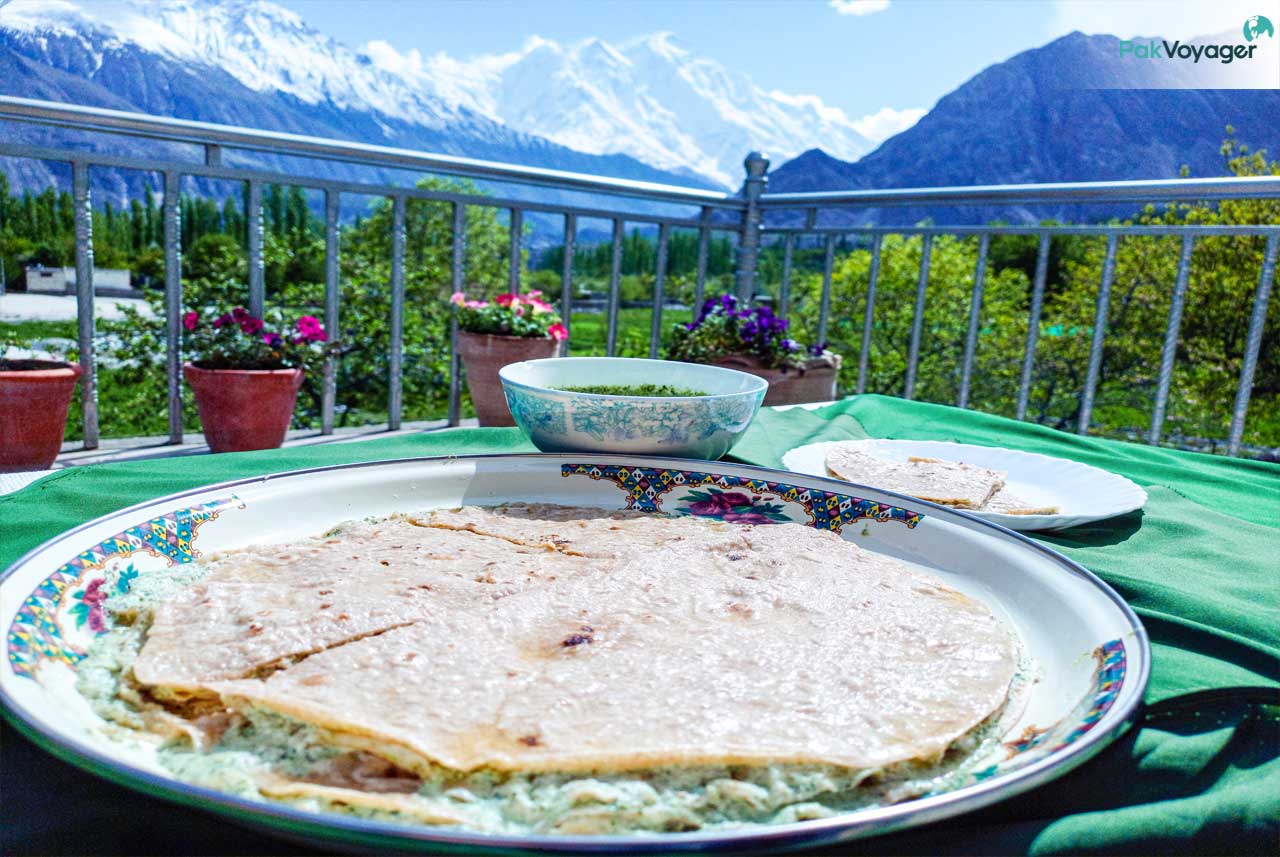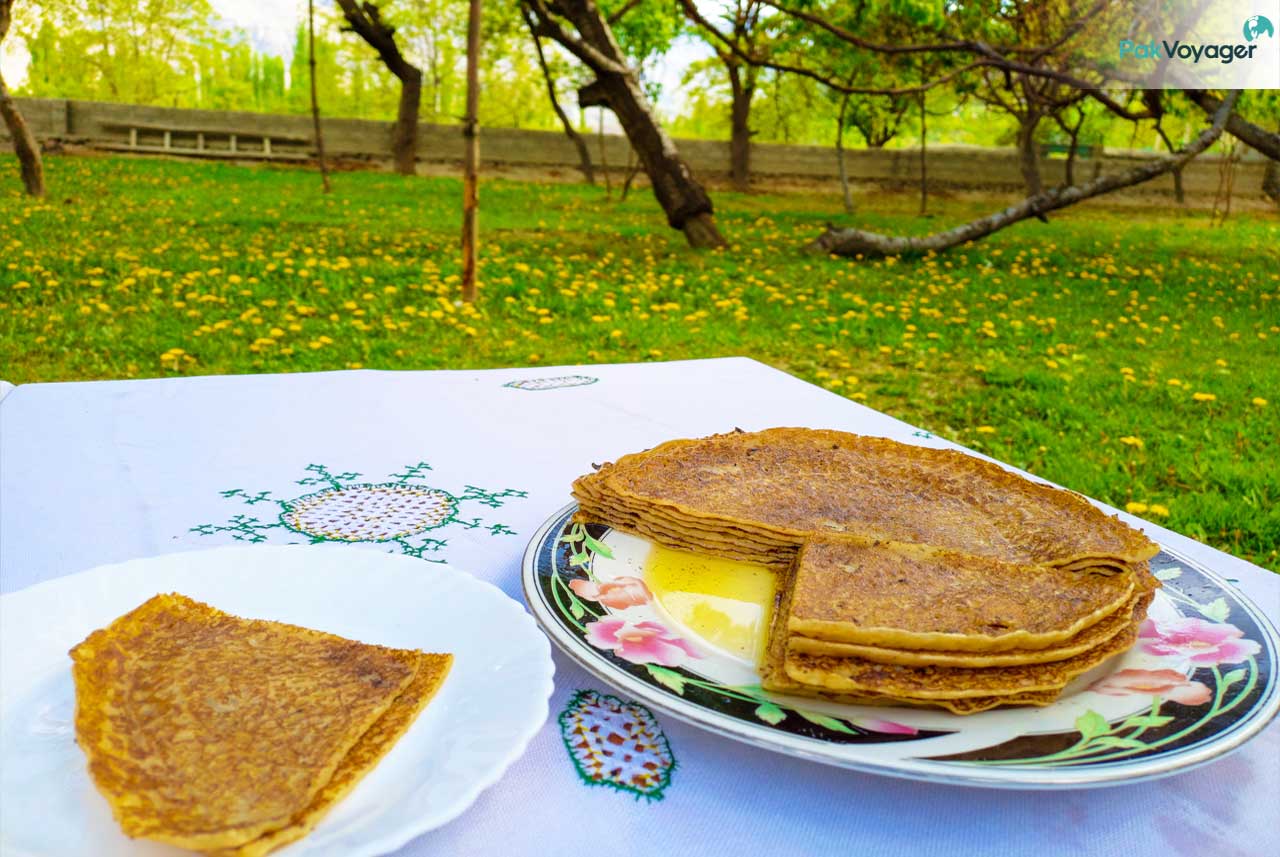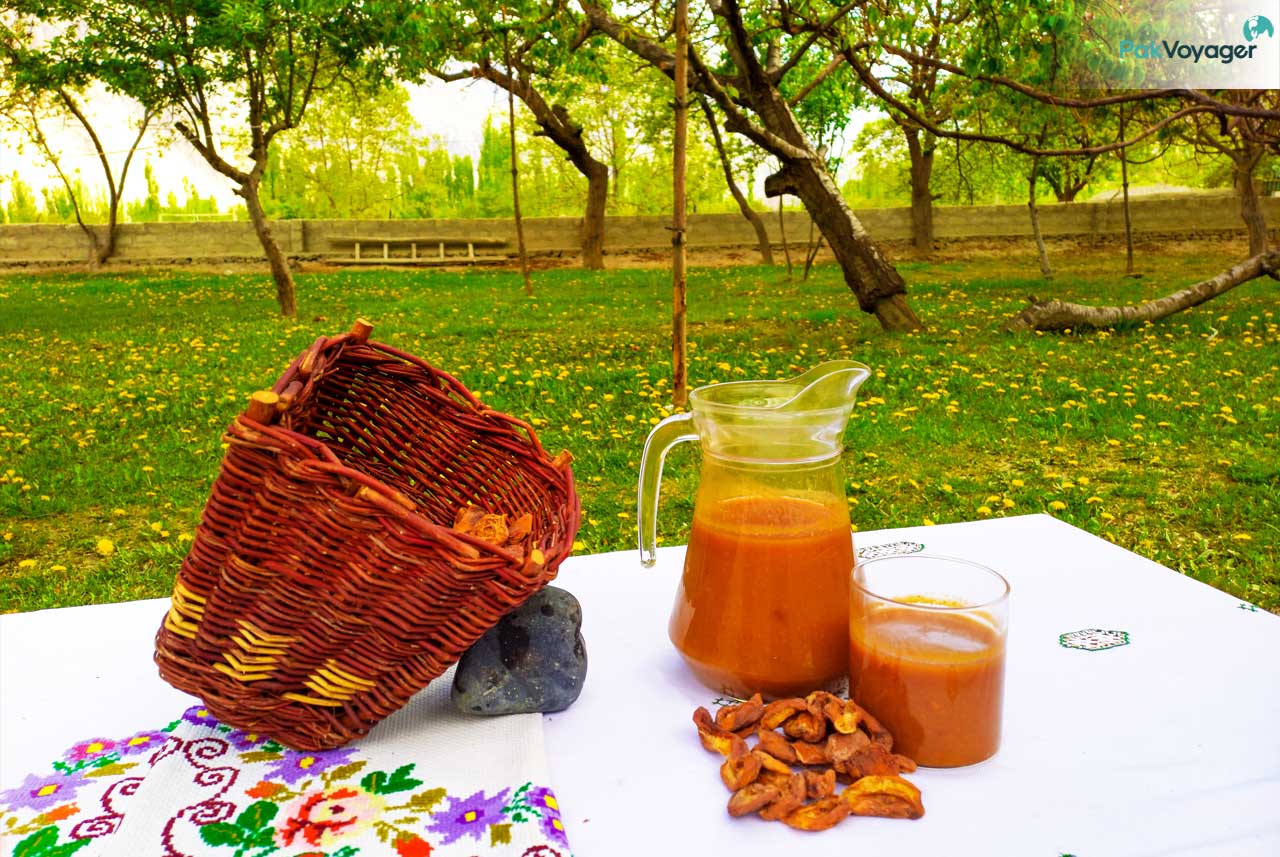15 Authentic Hunza Valley Traditional Food: Pure, Healthy, and Unique
Hunza Valley food is known for its pure and healthy diet that is totally different and unique from anything else you'll find across Pakistan. The people of the Hunza Valley had long lives due to the Hunza diet in ancient Hunza. The cuisine has been influenced by ancient cultures like those found along the Silk Road, which means it shares many similarities with other Central Asian countries.
If you’re looking for some traditional foods of Gilgit-Baltistan then Hunza Valley cuisine is just what you need. Aside from the organic and homegrown ingredients that can be found within each dish served here; this recipe also lacks spices which makes it different from most other Pakistani foods we know about or have tried before!
Travel back in time to Northern Pakistan where people live off the land and enjoy authentic food. Enjoy some of these organic delectable dishes at Luxury hotels in Hunza Valley as well as in authentic traditional food restaurants scattered across Hunza Valley.
The Hunza Valley Tour Packages from PakVoyager can take you to the fabled Hunza Valley to explore authentic Hunza Valley traditional food. Book Online Now Hunza hotels, and car rentals, or ask for a customized Hunza tour.
Try out these delicious Hunza food recipes from the land of Hunza!
BURUS SHAPIK
The most famous dish in this Hunza Valley is BURUS SHAPIK. Made up of two components - Booros/cottage cheese and Tzapick/flatbread- it’s traditionally reserved for special occasions or gatherings with family members. Nestled in the Karakoram Mountains Hunza Valley saw many harsh winter months consequently the food consumed by Hunzukutz is rich and wholesome to boost immunity and endure cold temperatures.

Burus Shapik Recipe:
Burus Shapik is made from yogurt that is boiled and whey is drained. Booros is mixed with mint and chopped green onions. Salt is added for taste.
Two thin flatbreads are baked on fire then cottage cheese mixture is applied between both the chapatis. Nut oil is brushed on the surface. One can also use melted butter instead of nut oil.
HOI LO GARMA
Rich and flavorsome Hoi lo Gaarma is a quintessential Hunza valley food. When you first bite into this delectable dish, the homemade pasta and Romaine lettuce come together in a delicious union of flavors that will leave your mouth watering for more.
How to Make Hoi lo Garma:
Romaine lettuce chopped and boiled, salt to taste, green onions, and thin-layered flatbread shaped pasta, potatoes, vegetable oil, apricot nut paste.
Initially, lettuce is chopped and boiled. Water is drained to get rid of impurities. In a pan add some vegetable oil and fry red onions until golden brown. Add boiled lettuce, potatoes, and salt and cook for a while till it gets tender. Pour a cup of water and let it simmer.
Roll pasta made of water and whole wheat flour into a thin round shape. When water starts to boil add apricot nut paste and add a layer of pasta, after five minutes add another layer of pasta and then another. Cook on low heat until pasta is soft and ready. Sprinkle green onions to make the dish more flavourful.

MOLIDA
Molida is a deliciously unique dish prepared in the Gojal valley. It's famous for its deliciousness, and it can be found at many festivals throughout Wakhi culture!
Molida is prepared with Yogurt, flatbread, and Apricot oil. It is an integral component of wedding events. Molida recipe is given below.
How to Make Molida:
In a pot warm Buttermilk on low heat and add chunks to baked flatbread. Mix well to incorporate both ingredients. Add salt according to taste. Bring this concoction to a boil, when it thickens remove from heat and serve in a bowl.
Create a small puddle in the middle and pour Apricot oil. Locals eat it in groups from the same bowl.
HARISSA
You may have come across Harees dish in the middle east but the Harissa prepared in Hunza Valley is a bit different. Harissa is usually made on special occasions such as festivals and funerals. It is a combination of wheat and meat (Mutton/beef) chunks.

How to Make Harissa:
The large cauldron is filled with chunks of fat and meat, cooked over an open fire. This takes hours to complete because it requires many people who will stir the mixture regularly in order for this dish not to become dry or burnt at any point during the cooking process.
When meat is cooked it is removed from the broth. Washed and dried wheat grains are added to the broth and fat mixture and cooked till grains become tender. This process takes a whole day to complete. The thick grainy mixture is served with chunks of boiled meat.
DIRAM PHITTI
Diram Phitti is also prepared on special occasions such as Nowruz, weddings, and Ginani. People of Hunza are used to strenuous physical work as a result Hunza cuisine is comprised of nutritious and wholesome food.
Diram Phitti has a natural sweetness. This dish is also prepared in other central Asian countries such as Uzbekistan, Afghanistan, and Azerbaijan.
How to Make Diram Phitti:
Diram/Flour is prepared from wheat sprouts. Wheat is soaked in water overnight and spread on a wet cloth to let it germinate for some days. This germinated wheat is dried and milled to get flour. The next step involves the preparation of a thick sticky dough using water and a small portion of wheat flour.
Small patties identical to burger patties are shaped and baked either on an open fire or in the oven. The baked Diran Phitti is mixed thoroughly with Apricot oil before consumption. Eat a spoonful dipped in apricot oil.
SHARBAT
Sharbat is a traditional Hunza food and a major component of Hunza cuisine that is made on special occasions such as wedding festivities. It takes a whole day to cook and requires constant stirring by men!
The people of Hunza used to bury butter discs in-ground pits, wrapped with birch bark and immersed underneath the soil. They would then store them at a cool place such as under a water channel until needed for use later on! This technique was an alternate to today's refrigeration process.

How to Make Sharbat:
The first step is to melt aged butter to remove impurities and contaminations. The process is similar to ghee-making. This aged butter has a very strong pungent smell. The next step involves grinding wheat. Wash and soak wheat grains and later coarsely grind them in a mortar and pestle.
The purified butter is heated in a cauldron on a wood fire, then water is added. When the liquid starts boiling, coarsely ground wheat is added and cooked for a long time. Indication of cooked Sharbart is that a layer of butter starts to accumulate on the surface.
Sharbat is served with a bowl of purified aged butter oil.
GYAL
Gilgit-Baltistan is home to some of the best food in Pakistan, and Giyaalin can be found in each part of the region however with different names. These crepes/pancakes are made from either whole wheat or buckwheat flour covered with walnut oil for taste while they can also be eaten with organic honey and apricot jam.
If you want your breakfast experience as authentic as possible try it alongside some salted tea. Gyal is not often made, usually, it is served to guests.

How to Make Giyal:
Whole wheat flour or buckwheat flour, water, an egg (optional), walnut oil.
Prepare a liquidy batter similar to pound cake batter by adding water to the flour. Pour a scoop of batter onto a pan on low-medium heat and spread it into a thin layer by using a ladle. Flip the side when it changes color to light brown. Apply nut oil to the surface before serving.
GHILMINDI
Ghilmindi-a Pamiri dish is prepared and served on special occasions such as plowing season. Ghilmindi is similar to Booros Tzapick in many ways. This traditional dish of Gojal-Hunza is a delicious and healthy combo.
This delicious dish can be prepared by pouring curd/Yogurt on each layer of bread and adding salt and red chili powder. The result is a salty-sour taste that will have you coming back for seconds!
How to Make Ghilmindi:
Prepare two layers of wheat bread/Chapati/Flatbread. Add Chili powder and salt to the curd and mix well. Apply a layer of concoction to one Chipattai and place the other chapatti over it just like a sandwich. Apply a generous amount of Apricot oil to the surface.
BERIKUTZ
Local festivals are a great time to enjoy the delicious and hearty food that epitomizes Hunza culture. One such dish, Berikutz is prepared by mixing apricot or walnut pastes together with roti which then gets cooked on an open fire until a golden brown exterior has formed while remaining moist inside.

How to Make Berikutz:
Apricot/walnut oil, Apricot nuts/Walnut paste, whole wheat flour dough.
Make a thick paste of nuts by adding some water. Roll dough into thin layers. For one berikutz you will need two rolled chapati shape layers. Apply the paste to one layer and place the other roti over it-sandwich paste between two chapatis.
Bake both sides on low-medium heat on a pan. Later apply nut oil to both surfaces.
SIKERKUCH CHAMIK
Shikerkutz chamik or fenugreek soup is a delicious, healthy, and nutritious dish that can be made instantly when someone has been extremely busy. The fenugreek found in Hunza Valley has a strong sweet fragrance and is best for Cholesterol control.
How to Make Sikerkuch:
Dried Fenugreek leaves are pounded into a powder. In a pot, vegetable oil is heated and chopped Onion is added. Add some red chili powder or green chili and salt.
Gradually mix fenugreek powder in a separate bowl along with a tablespoon of whole wheat flour to lessen the bitter taste. Pour water into a pot and add dry ingredients. Cook on low heat and bring it to a boil until you get a soupy texture.
Best eaten with dipped Chapati pieces.
Fitti
Fitti is a type of leavened round bread that has been cooked in Hunza for breakfast. In the past, people would bury their cast-iron skillets beneath hot coals and ash to create this thin crust soft center goodness we know today as !
Nowadays you can find these delicious flatbreads mostly in an oven - but there's still something satisfying about getting them straight from your fire pit or campfire. The rich, doughy texture of the bread combined with its robust flavor makes for an enjoyable Hunza breakfast.
The taste of the Fitti is best enjoyed with a cup o' tea. Just add some salt and butter to start off, then stir in pieces small.

How to Make Fitti:
Whole wheat flour, water as required, Salt for taste, Ghee, Sour Dough/yeast 1tsp.
Combine the dry ingredients in a bowl then add ghee and mix well until ghee is fully incorporated into the flour.
Now gradually pour lukewarm water into the flour mixture until you get a smooth dough. Let it rest for half an hour or 1 hour. Preheat oven.
Knead dough and roll with a rolling pin until you get a 2-inch thick round shape, poke holes on the surface with a fork and bake in the oven until it gets a golden brown color.
HUNZA Traditional SOUPS
Hunza food comprises of a variety of Hunza traditional soups. Traditional soups are a common type of Hunza dish, and they are typically made with wheat, meat or dry apricots. These soups are usually served to make warm in harsh winters. Hunza traditional soups are filling and satisfying, and they provide a healthy option.
BATTERING DAWDO
In the cold winter months, it's hard not to crave something warm and comforting. Battering dowdo is one such Hunza traditional soups that'll make your mouth water with anticipation. The delicious aroma will fill the room as you slip away at this sweet-and-sour blend. Battering in Brushaski language means dried Apricot which is the main ingredient of this soup. Battering Dawdo is an ideal remedy for cold, constipation, and flu.

How to Make Battering Dawdo:
Thoroughly wash dried apricots to remove dust. Take a pot and pour water. Bring it to a boil and add washed dried apricots. Cook on medium flame until you get a thick concoction of water and apricots.
In a separate bowl add a handful of wheat flour and sprinkle some water, rub this mixture with both hands to create small beads of dough. Add these dough beats to apricot mix and cook. Battering Dawdo or Apricot soup is served as it is and consumed especially on snowy days.
QURUT ZAY DAWDO
The traditional soup of Hunza valley Qurut Zay Dawdo is a soup with sour cheese sauce. A perfect balance of flavors and textures, the Hunza valley's Qurut Zay Dawdo is a soup with sour cheese sauce. The ingredients are simple but they come together beautifully to form one delicious meal! Especially for harsh Hunza winters.
It's also an excellent choice if have been sick because it is best for cold and flu and provides instant relief!

How to Make Qurut zay Dawdo:
Homemade Tagliatelle, Sour cheese, meat (beef, yak meat, or mutton), vegetable oil, spring onion, ginger/garlic paste, and tomatoes.
In a pot pour two tbsp vegetable oil and fry onions. Add chopped tomatoes, ginger/garlic paste, and meat cubes and let it cook. Add some salt, turmeric powder, and garam masala for taste. When meat is tender, pour 2 to 3 cups of water or meat broth and bring it to a boil. Add sour cheese paste or crushed powder. Now add the tagliatelle and cook. Dawdo is served piping hot.
HUNZA DRINKS
Hunza food is as diverse as the Hunza people themselves. One of the staples of Hunza cuisine is Hunza drinks, which are made of dried apricots.In addition to being delicious, Hunza juices are also packed with vitamins and minerals, making them an excellent way to stay hydrated and healthy.
CHAMUS
There is nothing more satisfying than quenching your thirst after a meal. Chamus does just that with its refreshing taste, leaving you feeling refreshed and ready for another round! A popular summer drink in Hunza Valley, Chamus is simple, nourishing, and wholesome.

How to Make Chamus:
Dried Apricots, and water. Wash dried apricots with hot water to remove impurities such as dust. In a spacious deep bowl add water depending on the quantity required.
Add dried Apricots and using both hands rub apricots continuously in water until you get a thick consistency.
Chamus is ready to serve.
GULLI CHIL
Gulli chil or Apricot water is a refreshing, healthy drink that's great for hot summer days. It only takes just water and dried apricots to make this tasty treat!

How to Make Gulli Chil:
Whole dried Apricots without removing seeds and water. Soak dry fruits in water for a whole night in a cool place. Drink juice with soaked soft apricots.
HUNZA CHAI
The people of Hunza drink a special kind of tea that is rich in flavor and has an unusual salty taste. This pattern of adding salt to tea can be found in other mountainous regions such as Baltistan, Tibet, and Ghizer.

How to Make Hunza Chai:
Hunza Chai Recipe involves 1 cup of water, milk, salt to taste, and tea leaves.
To make a delicious cup of tea, boil water after adding 2 tsp leaves. When it is boiling pour half a cup of milk and add salt to taste- let simmer for stronger flavor and rich aroma until it has turned creamy brown in color.
You may also add dried ginger powder for extra flavor before serving!
TUMURO CHAI
The Tumuro or wild thyme is a mountain herb found in the high-altitude pastures of Hunza. Tumuro chai or green tea is brewed with water to create an aromatic herbal blend that works wonders for indigestion and common flu.
How to Make Tumuro Chai:
Boil dried thyme leaves with water and it is ready. Tumuro is usually drunk as it is without sugar.
Hunza Valley Food is one of the healthiest and most nutritious diets in all of Pakistan comprised of organic ingredients. It's a simple living that has been consumed for centuries, which accounts for its people being among some longest-lived ethnicities around! In conclusion, Hunza Valley's traditional food is not only delicious but also provides many health benefits. So, if you ever have the chance to visit Hunza valley, make sure to try out some of these traditional dishes!
PakVoyager offers a range of online Hunza travel services, from hotel bookings, Hunza Tours to car rentals. With years of experience in the industry, we are able to provide our customers with the best possible rates and services. Our team of experts are on hand to help you plan your trip, and our online booking system makes it easy to book your travel services in advance. Whether you're looking for a romantic getaway or an action-packed adventure, PakVoyager has the perfect Hunza tour for you. Book your travel services today and let us take care of the rest.







